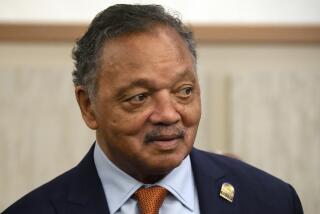Turnaround at NAACP Earns Mfume Second Term
- Share via
BALTIMORE — Under the five-year leadership of Kweisi Mfume, the NAACP has increased turnout by black voters in the South, put more black faces on television and removed the last Confederate flag to fly above a statehouse.
This weekend in Washington, the board of directors of the National Assn. for the Advancement of Colored People is expected to offer Mfume a new contract, which he has said he would accept. His first term as president ended Friday.
“I’d like to stay because my job isn’t finished,” Mfume said. “I believe this organization must do more to bring this nation together, to help define the issues of the day.”
Under his leadership, the 90-year-old organization has regained the relevance it had during the 1960s, when Roy Wilkins organized marches, sit-ins and freedom rides across the Jim Crow South.
“I think we can truthfully say that the organization is back all the way,” said University of Maryland political scientist Ronald Walters, who once criticized the NAACP for lacking activism. “They have really gotten back on the field of battle, where I think they’re supposed to be.”
Mfume, an adroit, 52-year-old former congressman, abdicated one of the House’s safest Democratic seats to assume responsibility for resurrecting the nation’s oldest civil rights organization.
His predecessor, Benjamin F. Chavis Jr., was ousted for allocating NAACP funds to quiet sexual harassment allegations against him. Donations flagged, staff was laid off and the budget deficit grew to $4.5 million.
“We had come out of the scandal, and I think it was [Mfume’s] integrity that really caught the attention of the board members,” said Julian Bond, the NAACP’s board chairman and a veteran civil rights activist. “We needed someone at the top we could trust.”
In his first week, Mfume laid off more staff. He then spent months visiting NAACP benefactors who had stopped donating, telling them, “It’s OK to come home to the NAACP.”
Within a year, there was a $2-million surplus. Now it’s $12 million.
Last year, the four major television networks committed to a more ethnically diverse fall season, following threats of lawsuits and boycotts.
The organization also spent $9 million increasing black voter turnout in the presidential election.
“That was one of my early criticisms of the NAACP, that they have not developed, in the post-civil rights era, any propensity to bring out the vote,” said Robert C. Smith, a political science professor at San Francisco State University. “They have now.”
In another throwback to the civil rights era, 50,000 people converged on Columbia, S.C., last summer to protest the Confederate flag flying over the statehouse since 1962. The flag came down July 1.
“I thought that said, in many ways, that the NAACP was back to striking a chord on the issues that resonated with people,” Mfume said.
But Mfume has not converted everyone.
Michael Meyers, head of the New York Civil Rights Coalition and a former NAACP executive, criticized Mfume for addressing last year’s Democratic National Convention.
Meyers said the NAACP is in danger of becoming “a wholly owned subsidiary of the Democratic Party.”
“I don’t think [the NAACP] has the respect of people who are critical thinkers,” Meyers said. “But it’s well-liked by corporations and it’s well-liked by media.”
More to Read
Sign up for Essential California
The most important California stories and recommendations in your inbox every morning.
You may occasionally receive promotional content from the Los Angeles Times.













